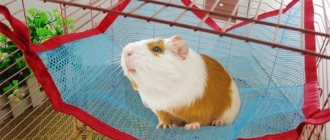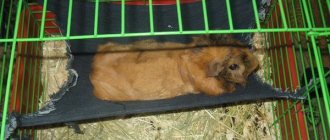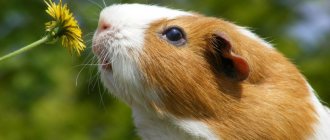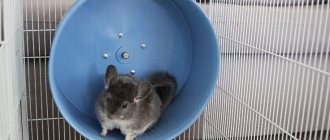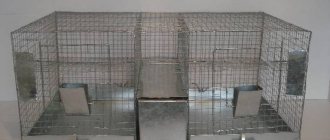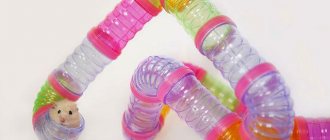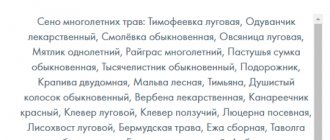All pigs, regardless of the type, need a daily portion of fresh hay: short-haired Selfies, long-haired Peruvian piglets and hairless Baldwin guinea pigs, and all other breeds. If you simply put grass on the floor of the cage, your pet will scatter it and get it dirty, and animals are contraindicated from eating dirty foods. Therefore, every pig breeder sooner or later asks the question: how to make a hay barn for a guinea pig? The answer to this question and useful information about hay can be found in this article.
Why does a guinea pig need hay?
Hay is a vital and essential component of a guinea pig's diet. The main issue is the quality of hay, because it differs in composition, freshness, fiber content and essential nutrients.
A rodent can live happily if it is kept in a fairly spacious cage, is healthy, and has plenty of hay and water. Dry plant foods are essential for healthy digestion and the prevention of dental problems. In addition, hay contains a surprising amount of nutrients that your guinea pig needs for proper growth, development, and overall health.
Regardless of the type of feeding you choose, your pet guinea pig should have unlimited access to fresh, quality hay on a daily basis.
In the wild, rodents have access to different types of vegetation. Wild relatives of guinea pigs feed on grass, shoots, branch bark, wild berries, fruits, and root vegetables.
A varied diet allows a wild rodent to provide itself with all the necessary nutrients, maintain the health of the digestive system and grind its teeth in a timely manner.
Note! All pets live in unnatural conditions, so the owner is responsible for adjusting the diet depending on living conditions.
Poisonous plants
When going to a field or forest to look for green food for your pet, do not forget that there are dangerous plants that can cause not only severe poisoning, but also the death of your pet.
Not all grass can be eaten
Deadly plants
Remember this list of poisonous plants that guinea pigs should not eat:
- sorrel leaves;
- nightshade leaves and shoots;
- leaves of lilies of the valley, daffodils;
- aloe;
- arum;
- fighter;
- celandine;
- hyacinths;
- lily;
- fern;
- geraniums of all kinds;
- henbane;
- digitalis;
- wild radish;
- stinking dope.
Feeding with such plants can be fatal.
Food poisoning
The following plants, which can cause food poisoning, are considered no less dangerous for guinea pigs:
- ivy of all kinds;
- wild mustard;
- wisteria;
- gorse;
- honeysuckle;
- dogwood;
- yew;
- laurel;
- derain;
- hellebore;
- common broom.
Of the tree species, guinea pigs are prohibited from giving hellebore and belladonna greens, privet, mistletoe, oleander, thuja, juniper and elderberry.
Article on the topic: How long can a guinea pig live without food and water, how many days can it be left alone at home?
If you come across a poisonous plant
There is nothing wrong with this if, while feeding grass, the animal eats a couple of poisonous leaves or twigs. After all, as you know, poisons in small quantities are medicine. The degree of concentration of toxic substances in plants depends on the time of day and year.
Guinea pigs have a unique sense of touch and smell, so the animals themselves determine which food is best for them and will not harm them.
If it happens that the pig tastes a poisonous plant and feels unwell, it will remember it and avoid it next time.
Which hay is best for guinea pigs?
Many owners have questions, because hay is not the only food for guinea pigs that contains fiber. Not the only one, but the richest and lowest in calories. However, hay also varies; some types of grass contain large amounts of vegetable protein, natural sugar and calcium.
Since guinea pigs chew hay almost during the entire waking period, overeating and obesity are an obvious problem if plant foods are not selected correctly.
Note! A diet high in protein and calories is only suitable for pregnant, lactating and very young individuals.
You need to understand that the guinea pig’s body is physically unable to absorb a lot of protein and calcium, as a result of which, if fed improperly, sand and stones form in the animal’s bladder.
Ready-made hay from the store - selection rules
The composition of hay is not the only factor that you should focus on. Much more important is the quality and freshness of plant foods. The fresher the hay, the higher its nutritional value. It is important not to confuse calorie content with the content of essential nutrients. The longer the hay sits (stored), the more useless it becomes.
Meadow and grass hay is grown in the spring, and the first harvest occurs in early summer. Manufacturers of prepared food for rodents have long practiced re-growing - the cut grass is allowed to grow and harvested again.
Interesting! A pet store may sell a second or even a third crop. Moreover, the later the harvest, the lower the calorie content of the hay.
Ready-made hay from the store - selection rules:
- First Harvest – The grass stems of the first hay harvest have a clear structure and contain more fiber. The first harvest is healthier and contains young seed heads (tasty, but not as healthy), but differs from the second and third harvest in terms of toughness. It turns out that it is better to feed a guinea pig hay from the first harvest, but the pet itself will prefer the second.
- The second harvest is hay that is soft to the touch and large (wide). For guinea pigs, such food is tastier and more aromatic. Additionally, second harvest hay contains fewer seed heads and more stems, which is better for your teeth and digestive system.
- The third crop , hay, consists almost entirely of wide leaves and large stems. Third-cut hay is not very suitable for constant feeding, but guinea pigs like it. In addition, in terms of nutritional value, third-cut hay is close to bean hay or alfalfa.
Note! Pet stores often sell “pure” dried alfalfa. Guinea pigs love this grass and eat it with great pleasure. However, experts categorically do not recommend giving pigs a lot of alfalfa, much less replacing hay with it.
DIY sennik
Hay can be placed in a cage in a bale, but this is not aesthetically pleasing and is dangerous, since the pigs will scatter the grass and stain it. It is more practical to place the hay in a special feeder, which will not allow the animals to scatter the contents. Rodent cages are usually equipped with a container for hay. Ready-made hay can be easily found in pet stores.
Many breeders prefer to make hay barns on their own, especially since there is a lot of scope for imagination here.
You can fill any container, box, soft toy, or even a sock with hay. Don't immediately throw away egg trays and toilet paper tubes. By filling them with hay and offering them to your pet, you can make the rodent happy and keep him occupied for several hours.
A simple haybox made from plastic containers
To make a feeder, you will need a disposable plastic container or any plastic container you have at hand, and paper clips (2 or more). The container is filled with hay and attached to the bars of the cage using clothespins. The convenient sennik is ready!
All that remains is to regularly fill it with food. If piglets show interest in paper clips, it is better to hang the clothespins higher so that the pigs do not get hurt.
How to sew a hay bag
Procedure:
- Two identical pieces of fabric (20x30 cm) are folded with the right sides facing each other.
- Next, you need to draw two round windows in the center at a certain distance from each other.
- Windows are cut out on one of the flaps, and the edges of the windows are finished with stitching.
- The product is sewn on three sides, the top remains unsewn.
- The edges of the top must be folded and stitched, after which the product is turned inside out (it turns out to be a bag).
- Then you need to sew 4 ties, 2 on each side of each edge (you get a handbag with handles).
- The bag is stuffed with hay and hung in a cage.
Sennik out of the box
You can build a feeder from a shoebox or small household appliances; it is important that it fits the size of the cage. A lid and one side wall are not needed. The side can be cut off, leaving 5 mm from each edge. Holes are made on two narrow side walls (4 on each side). The sennik is attached to the bars of the cage using fishing line or wire, which is threaded through these holes. The container is filled with hay and the hay barn is ready.
Wooden canopy
For production you will need:
- boards or furniture board;
- drill with grinding attachment;
- jigsaw;
- metal grill;
- hammer;
- furniture dowels (6 mm).
Progress:
- The boards are sawn into pieces: 2 sides 10x13cm; bottom 10X14cm; back wall 18X11 cm.
- Recesses for the grate are cut in the side walls (the width coincides with the width of the found grate).
- The upper part of the backdrop can be cut in a semicircle (optional).
- Next, the holes are marked at the joints, after which the holes are drilled with a five-millimeter drill.
- The dowels are driven into the holes in the sides with a hammer, and the back and side walls are connected.
- Then the dowels are inserted into the lower part, and the structure is assembled.
- Next, the product must be sanded and the corners smoothed.
- The grille is inserted into the grooves.
- Holes are drilled in the back for attaching to the cage, the hay box is filled with hay and hung.
Rules for storing hay at home
Almost all pet stores sell hay packaged in plastic bags. After the expiration date, you risk purchasing a rotten mixture.
Rules for storing hay at home:
- Regardless of whether you bought hay or prepared it yourself, store the mixture only in open form.
- The humidity in the room where hay is stored should not exceed 40% in summer and 50% in winter.
- Turn and loosen the hay regularly to allow it to “breathe.”
If storage rules are violated, dry grass begins to rot. At first, a barely noticeable, sweetish odor appears. Afterwards the mixture begins to heat up and rot. As hay rots, mold may form on the hay.
Rules for feeding guinea pigs hay
Guinea pigs require a lifelong diet that is rich in fiber. It is thanks to the hay, which the pet chews almost around the clock, that its digestive tract can function smoothly and correctly.
Note! Guinea pigs' incisors grow quickly and throughout their lives. Constantly chewing rough food is the only way to wear teeth naturally.
The best way to provide your guinea pig with enough coarse fiber is to follow the rules for feeding guinea pigs with hay:
- You must know the composition of the hay and its origin.
- The hay should be fresh, dry and aromatic.
- Hay should be available to the pet around the clock.
Many owners face a common problem - their guinea pig wastes more hay than it eats. The pet drags hay around the cage and gets it dirty. This problem can be quickly solved with the help of a special feeder.
What to do if your pig refuses to eat hay
The owner should be concerned if the pig refuses to eat hay. There are many possible reasons, but the most common ones are:
- Stale or rotten hay.
- The presence of poisonous herbs in the mixture.
- Problems in the gastrointestinal tract.
If your pet appears lethargic or weak while refusing hay, contact your veterinarian immediately. All diseases and dangerous conditions in guinea pigs develop rapidly, so delay can cost the pet’s life.
Herbs and greens
Guinea pigs should be offered herbs and greens. 1 – 2 types per day
, after washing and drying from excess moisture.
You can: beet and carrot tops, dill, celery, lettuce, alfalfa, plantain, clover, sage, chamomile, burdock, nettle, echinacea.
Rarely: parsley, spinach, dandelion, asparagus, milk thistle, St. John's wort, coltsfoot, fireweed.
You can’t: shoots of onion and garlic, sorrel, rhubarb, lettuce, celandine, belladonna, fern, sow thistle, valerian, lavender, serpentine, poppy, laurel, wolfberry, buttercup, spurge.
